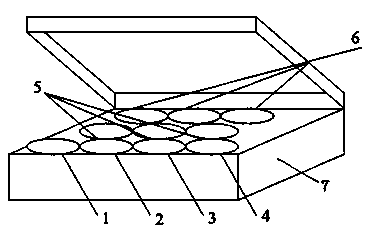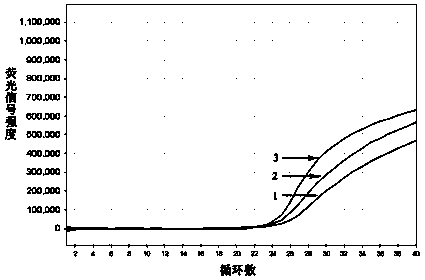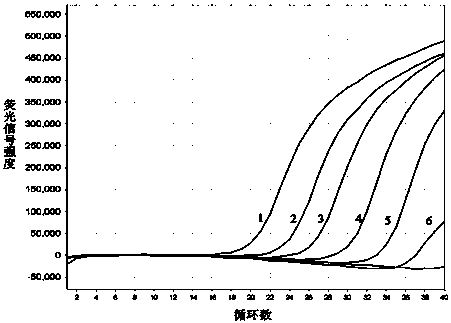Triple fluorescent quantitative RT (Reverse Transcription)-PCR (Polymerase Chain Reaction) kit for detecting human calicivirus
A fluorescence quantification and reagent kit technology, applied in the biological field, can solve the problems of waste of reagent consumables, time-consuming and labor-intensive, etc.
- Summary
- Abstract
- Description
- Claims
- Application Information
AI Technical Summary
Problems solved by technology
Method used
Image
Examples
Embodiment 1
[0047] see figure 1 , a triple fluorescent quantitative RT-PCR kit for detecting human calicivirus, characterized in that the kit consists of quantitative RT-PCR reaction solution tube 1, enzyme mixing solution tube 2, primer probe mixing solution tube 3, negative The control quality tube 4, three standard quality tubes 5, three positive control quality tubes 6 and the box body 7 are composed.
[0048] Wherein quantitative RT-PCR reaction solution tube 1 contains PCR reaction buffer, magnesium chloride and deoxyribonucleotide triphosphate mixture; enzyme mixture tube 2 contains heat-resistant Taq DNA polymerase, RNase inhibitor and MMLV reverse transcriptase; primer The probe mixture tube 3 contains specific primers for three types of Norovirus GI, Norovirus GII, and Zarovirus and corresponding three fluorescently labeled probes; three standard tubes 5 are respectively placed in Type GI Norovirus standard substance, GII type norovirus standard substance, and Zarovirus standa...
Embodiment 2
[0069] 1 Materials and methods
[0070] 1.1 Clinical specimens and viral nucleic acids:
[0071] The clinical samples of Norovirus GI, Norovirus GII, and Zarovirus were obtained from the stool or rectal samples of patients with diarrhea in the First Affiliated Hospital of Zhejiang University School of Medicine, the Children’s Hospital Affiliated to Zhejiang University School of Medicine, and several other hospitals in Zhejiang Province. Swab specimen, which is shipped to the laboratory after the sample is collected. All positive nucleic acids were confirmed by gene sequencing.
[0072] 1.2 Primers and probes
[0073]Multiple gene sequences covering Norovirus GI, Norovirus GII, and Zarovirus at home and abroad were downloaded from the NCBI gene bank in the United States. The homology comparison was carried out using DNAman software to determine the conserved regions of the above viral genomes. Primer Express 3.0 software was used to design highly specific primers and Taqman...
PUM
 Login to View More
Login to View More Abstract
Description
Claims
Application Information
 Login to View More
Login to View More - R&D
- Intellectual Property
- Life Sciences
- Materials
- Tech Scout
- Unparalleled Data Quality
- Higher Quality Content
- 60% Fewer Hallucinations
Browse by: Latest US Patents, China's latest patents, Technical Efficacy Thesaurus, Application Domain, Technology Topic, Popular Technical Reports.
© 2025 PatSnap. All rights reserved.Legal|Privacy policy|Modern Slavery Act Transparency Statement|Sitemap|About US| Contact US: help@patsnap.com



